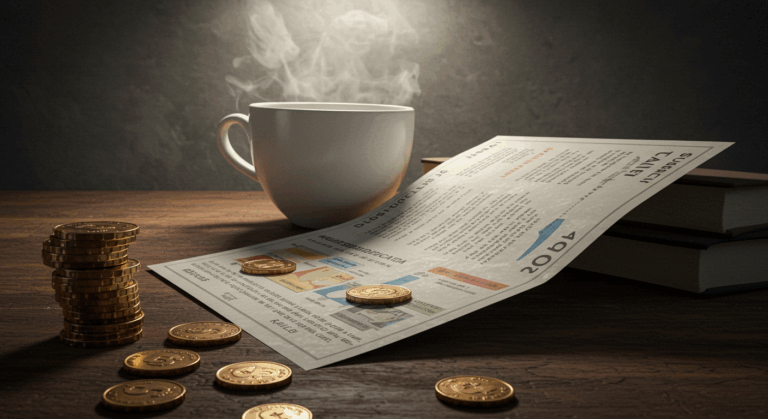What Is GDP and Why Should You Care? Explained for Non-Economists
You have likely heard the term Gross Domestic Product, or GDP, mentioned frequently in the news. Commentators discuss whether it is rising or falling, and political leaders often set their policy goals around its growth. But for many, it remains an abstract concept. What does this key economic indicator actually measure, and more importantly, how does it affect your daily life, your job, and your financial future? Understanding GDP is not just for economists; it is a crucial piece of knowledge for anyone looking to make smarter decisions about their personal finances.
This article will demystify GDP. We will break down what it is, how it is calculated, and why its trends have a direct and tangible impact on your wallet. By the end, you will be able to interpret news about the economy with greater confidence and understand the forces shaping your financial environment.
Decoding Gross Domestic Product: The Economy’s Price Tag
At its core, Gross Domestic Product is the most comprehensive measure of a nation’s economic activity. It represents the total monetary value of all the final goods and services produced within a country’s borders over a specific period, typically a quarter or a year. Think of it as a country’s annual economic report card. If a country were a giant business, its GDP would be its total revenue for the year.
The term final is important. GDP only counts the value of the final product to avoid double-counting. For example, it counts the price of a car you buy, but not the value of the steel, tires, and glass that were used to build it. The value of those intermediate components is already included in the car’s final price. This single, massive number gives us a snapshot of the size and health of a country’s economy.
Economists typically express the calculation of GDP with a straightforward formula: GDP = C + I + G + (X – M). Let’s briefly break that down:
- C is for Consumption: This is the largest component and represents all spending by households on goods (like groceries and cars) and services (like haircuts and internet subscriptions).
- I is for Investment: This includes spending by businesses on new equipment, software, and buildings. It also includes residential construction.
- G is for Government Spending: This covers all government expenditures on goods and services, such as defense, infrastructure projects like roads and bridges, and the salaries of public employees.
- (X – M) is for Net Exports: This is the value of a country’s exports (X) minus the value of its imports (M). If a country exports more than it imports, this number adds to GDP. If it imports more, it subtracts from GDP.

Why GDP Growth is the Goal
When you hear that the economy is growing, it almost always means that real GDP is increasing. Positive GDP growth, or economic expansion, is a sign of a healthy, thriving economy. It indicates that businesses are producing and selling more, which in turn leads to a cascade of positive effects. Companies are more profitable, they are more likely to hire new employees, and they may be in a better position to offer raises and promotions.
Conversely, a decline in GDP signals economic contraction. A prolonged period of negative GDP growth is known as a recession, a word that often brings to mind widespread financial hardship. During a recession, businesses scale back, unemployment rises, and consumer confidence plummets. This is why governments and central banks work so hard to foster stable and consistent GDP growth.
The Direct Link Between GDP and Your Personal Finances
This is where the economic data meets your reality. The direction of GDP has very real consequences for your financial well-being, influencing everything from your job security to your investment returns.
Job Market and Income: A strong, growing GDP is your best ally in the job market. When the economy is expanding, companies need more workers to meet rising demand. This creates job opportunities and can lead to lower unemployment rates. Furthermore, in a tight labor market, you have more leverage to negotiate a higher salary or seek better employment. In a shrinking economy, the opposite is true; layoffs become more common, and wage growth stagnates.
Investment Performance: Your investment portfolio is closely tied to the health of the economy. Corporate profits tend to rise and fall with the economic cycle. Strong GDP growth often translates to higher revenues and earnings for companies, which can drive stock prices up. When you invest in stocks or mutual funds, you are essentially betting on the future growth of the economy. Understanding GDP trends can help you make more strategic investment decisions.
Interest Rates and Borrowing Costs: Central banks, like the Federal Reserve in the U.S. or the European Central Bank, monitor GDP data very closely when setting monetary policy. If the economy is growing too quickly and they fear inflation, they might raise interest rates. This makes borrowing more expensive for mortgages, car loans, and credit cards. However, it also means you will earn more interest on your savings accounts. If GDP is weak, they might lower rates to encourage spending and stimulate the economy.
What GDP Doesn’t Measure: The Full Picture
While GDP is an indispensable tool, it is not a perfect measure of a society’s well-being. It is important to understand its limitations to have a balanced perspective. For instance, GDP does not account for income inequality. A country’s GDP could soar, but if that wealth is concentrated in the hands of a very small percentage of the population, the average person’s standard of living may not improve.
Furthermore, GDP fails to capture non-market transactions, such as volunteer work or the value of a stay-at-home parent’s labor, which are immensely valuable to society. It also does not consider the environmental costs of production. A factory might add to GDP by manufacturing goods, but the pollution it generates, which harms public health and the environment, is not subtracted from the calculation. Finally, GDP is not a measure of happiness, health, or overall quality of life.
Conclusion: Using GDP as a Financial Tool
Gross Domestic Product is much more than an abstract number for academics and politicians. It is a powerful indicator of the economic tide that can either lift or lower your personal financial boat. A growing GDP fosters an environment ripe with opportunity—for employment, for higher wages, and for investment growth. A shrinking GDP signals potential challenges ahead.
By understanding what GDP represents and how it influences the world around you, you are better equipped to navigate your financial life. You can interpret economic news with more clarity, anticipate potential shifts in interest rates, and make more informed decisions about your career, savings, and investments. This knowledge empowers you to build a more resilient financial future, regardless of which way the economic winds are blowing.
Frequently Asked Questions (FAQ)
What is the difference between real GDP and nominal GDP?
This is a critical distinction. Nominal GDP measures a country’s output using current market prices, without factoring in the effects of inflation. This means nominal GDP can increase simply because prices have gone up, not because more goods and services were produced. Real GDP, on the other hand, is adjusted for inflation. It is calculated using the prices of a base year, providing a much more accurate picture of whether an economy’s output is actually growing. For this reason, economists and analysts almost always focus on real GDP when discussing economic growth.
How does GDP per capita relate to the main GDP figure?
GDP per capita is calculated by dividing a country’s total GDP by its total population. The result is the average economic output per person. It is often used as a rough metric to compare the standard of living between different countries. For example, a country with a high GDP but a very large population might have a lower GDP per capita than a smaller country with a more modest GDP. However, like the main GDP figure, it is an average and does not reveal anything about income distribution or inequality within the country.
Can a high GDP ever be a bad thing?
In itself, a high GDP is a sign of a large economic output, which is generally positive. However, the nature of that GDP matters. Extremely rapid and unsustainable growth can lead to significant problems, such as high inflation, which erodes purchasing power, or an asset bubble that could eventually burst. Furthermore, if GDP growth comes at the expense of severe environmental degradation or widens the gap between the rich and poor, its benefits may not outweigh its societal costs. Therefore, policymakers increasingly focus on achieving sustainable and inclusive growth, not just growth at any cost.





